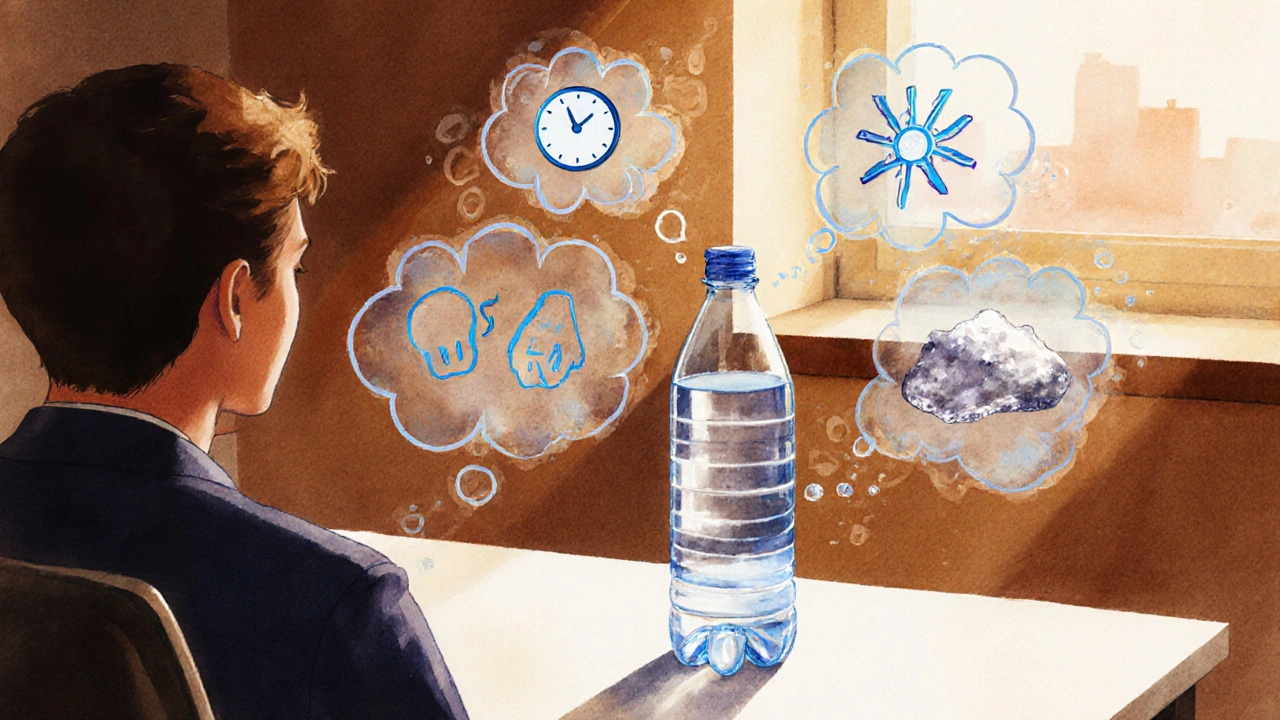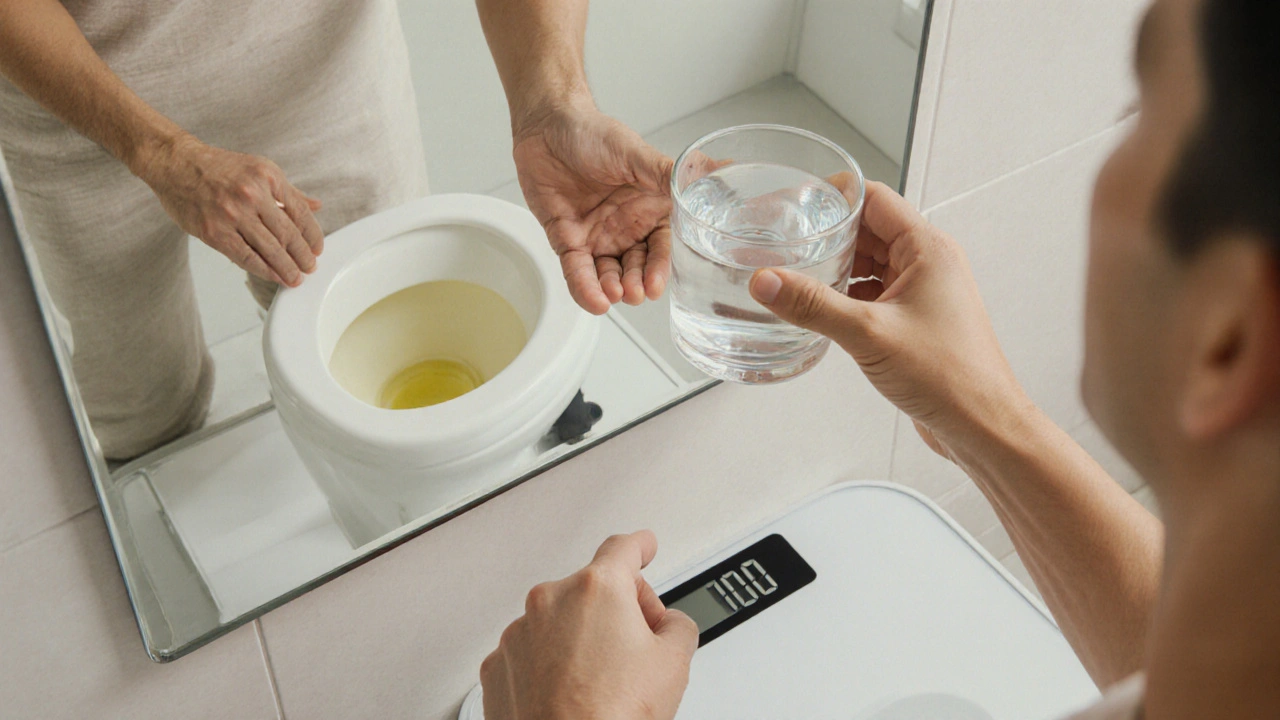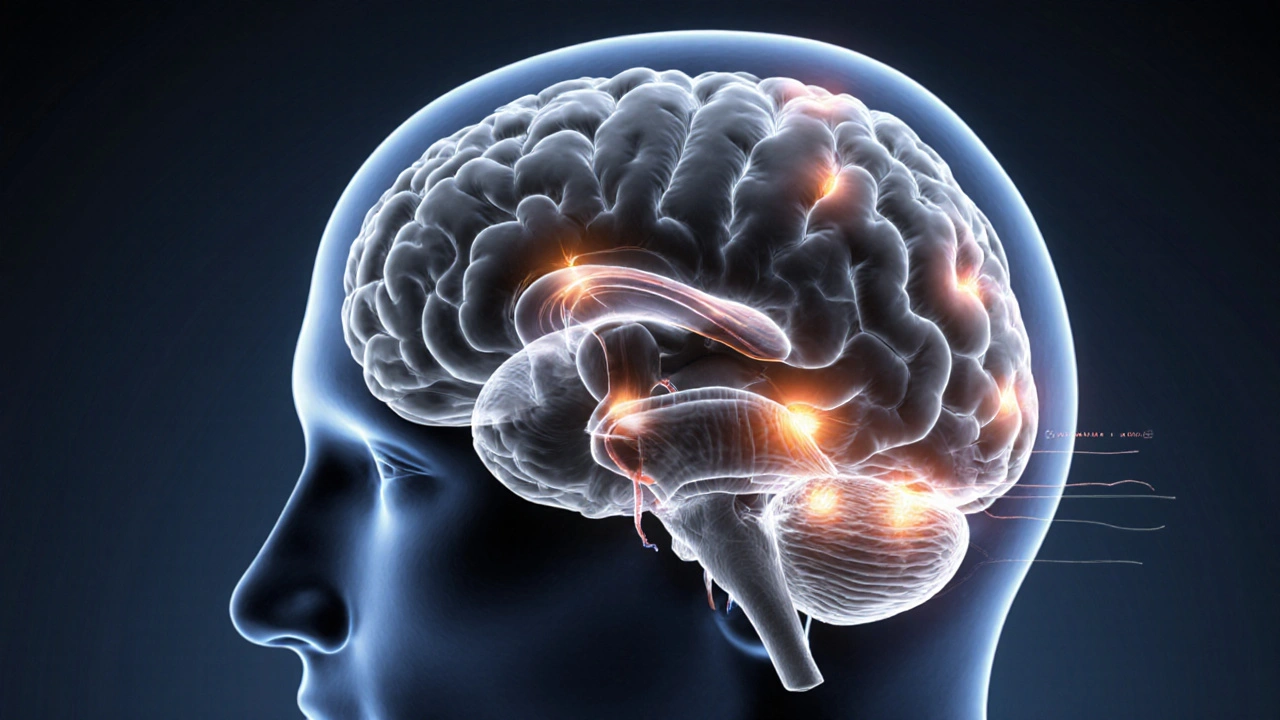Thirst Reality Checker
Thirst Analysis Result
Ever felt a dry mouth and reached for a glass even though you just finished a big bottle of water? That odd sensation is the focus of the psychology of thirst, a blend of body signals and mind tricks that can make you think you’re dehydrated when you’re not.
Quick Takeaways
- Thirst isn’t just about blood‑water levels; the brain also reacts to thoughts, habits and even the time of day.
- Key hormones - especially antidiuretic hormone (ADH) - tell the hypothalamus when to fire the thirst alarm.
- Psychological cues like stress, salty cravings or a habit of sipping water can override real hydration status.
- Distinguishing real from false thirst helps avoid over‑drinking and supports better overall fluid balance.
- When you’re unsure, simple checks (urine color, body weight) can confirm true hydration.
How Thirst Works on the Physiological Side
First, let’s break down the body’s wiring. When blood osmolality rises - meaning there’s more solute than water - special cells in the hypothalamus detect the change. These cells release antidiuretic hormone (ADH), also called vasopressin, which tells the kidneys to hold onto water and signals the brain that you need to drink.
At the same time, receptors in the mouth and throat sense dryness, sending a rapid “drink now” message to the brain. This dual system - blood chemistry plus oral sensation - is why genuine dehydration feels urgent and why a glass of water instantly relieves it.
Why You Can Feel Thirsty Even When Hydrated
Even with normal blood fluid balance, the brain can fire a thirst cue for reasons unrelated to osmolality. Here are the most common culprits:
- Psychological anticipation: Seeing a water bottle or hearing the word “thirsty” can trigger a conditioned response. It’s the same brain loop that makes you crave popcorn at a movie.
- Habitual sipping: Many people develop a routine of drinking every hour. Over time, the habit becomes a mental cue, independent of actual need.
- Stress and anxiety: The sympathetic nervous system boosts mouth dryness, prompting a false thirst signal.
- Dietary factors: Salty or spicy meals increase oral sodium levels, which the brain interprets as a sign to ingest more water, even if you’re already hydrated.
- Circadian rhythm: Research shows that thirst perception peaks in the early evening, a time when the body’s circadian clock expects fluid intake before sleep.

Psychological Triggers That Override Real Signals
Our brains love shortcuts. If you’ve ever finished a long run and felt thirsty before you actually lost water, you’ve experienced a learned association. The psychology of thirst treats visual and auditory cues as part of the “need” calculation.
Stress hormones like cortisol can also make the mouth feel dry, a phenomenon called “dry mouth of anxiety.” Even mild dehydration that never actually occurs can feel real because the brain interprets the dry‑mouth sensation as a need for fluid.
Another subtle factor is flavor. Sweet or salty drinks can create a taste memory that triggers thirst - not because you need water, but because your brain expects a reward.
Common Misconceptions About Thirst
- “If I’m not sweating, I don’t need water.” Even non‑exercise activities like reading or working at a desk cause subtle fluid loss through respiration.
- “Clear urine means I’m perfectly hydrated.” Urine color varies with diet, supplements, and timing of last void; it’s a useful guide but not a strict rule.
- “Drinking more water always helps.” Over‑hydration can dilute blood electrolytes, leading to hyponatremia - a real risk for marathoners and people who obsessively sip.
Practical Ways to Tell Real Thirst From False Thirst
When you’re unsure, try one of these quick checks:
- Urine color test: Light yellow (pale straw) usually indicates adequate hydration.
- Weight check: Weigh yourself before and after a workout; a loss of 1-2% body weight often signals fluid loss.
- Skin turgor: Gently pinch skin on the back of your hand; if it snaps back quickly, you’re probably fine.
- Thirst latency: If you can wait 20-30 minutes after the first urge without discomfort, the signal might be psychological.
By using these tools, you can avoid the habit of drinking out of boredom or stress.
Managing False Thirst Without Over‑Drinking
Here are some low‑effort strategies to keep your fluid intake in check:
- Set a sipping schedule: Instead of a glass every 30 minutes, limit to 8‑10 ounces every two hours unless you’re exercising.
- Swap with low‑calorie alternatives: Herbal tea or flavored water (cucumber, lemon) satisfies the habit without extra calories.
- Address stress directly: Deep breathing, short walks, or a quick meditation can reduce the dry‑mouth feeling caused by anxiety.
- Mindful eating: Reduce salty snacks if they’re the main trigger for your water cravings.

When to Seek Professional Advice
If you notice any of the following, talk to a health professional:
- Persistent excessive thirst despite normal urine and weight.
- Frequent urination with large volumes (possible diabetes).
- Swelling, headaches, or confusion after drinking large amounts of water.
These could signal underlying conditions like diabetes insipidus, electrolyte imbalances, or kidney issues.
Comparison: Physiological vs. Psychological Thirst
| Aspect | Physiological Thirst | Psychological Thirst |
|---|---|---|
| Primary trigger | Increased blood osmolality or low blood volume | Visual cues, stress, habit, dietary salts |
| Key hormone | Antidiuretic hormone (ADH) | None (brain’s reward circuits) |
| Typical sensation | Dry mouth + urgent desire to drink | Gentle urge, often triggered by external cues |
| Recommended action | Drink water promptly, monitor urine | Assess real need, use mindfulness or alternative fluids |
| Associated risks if ignored | Dehydration, heat illness, kidney strain | Over‑hydration, hyponatremia, unnecessary calorie intake |
Bottom Line
The psychology of thirst shows that thirst is as much a mental habit as a bodily alarm. By learning to read the true signals - the blood’s osmolality, ADH levels, and simple physical checks - you can keep your hydration on point without falling into the trap of over‑drinking. Remember: a glass of water is great, but it’s even better when it’s the right amount at the right time.
Frequently Asked Questions
Can stress really make me feel thirsty?
Yes. Stress triggers the sympathetic nervous system, which reduces saliva production and creates a dry‑mouth feeling. The brain often interprets this dryness as a need to drink, even if you’re fully hydrated.
Why does my thirst increase in the evening?
Your internal circadian clock regulates many body functions, including fluid intake. Studies show a natural rise in thirst perception a few hours before sleep, possibly to prepare the body for overnight fluid balance.
Is it possible to drink too much water just because I feel thirsty?
Yes. If the urge is driven by habit or anxiety rather than actual dehydration, you can dilute blood sodium levels, leading to hyponatremia. This is rare but can be serious, especially in endurance athletes or people who force themselves to drink large volumes.
How can I tell if my thirst is real or just a habit?
Try the “20‑minute rule": When you first feel thirsty, wait 20 minutes without drinking. If the sensation fades, it was likely psychological. If it stays strong, you probably need fluid.
Should I change the type of water I drink?
Tap, filtered, or bottled water all hydrate equally. If you’re prone to over‑drinking, consider flavored water with a slice of fruit or herbal tea to satisfy the habit without adding excessive volume.


Oh, the bitter irony of sipping crystal‑clear water while the mind screams a thirst that never existed! 🌊😱
Enough of this pseudo‑science mumbo‑jumbo; real Americans know thirst is just a brain‑washed excuse to drink soda. 💪
True hydration depends on blood sugar and salt levels and not on patriotic anecdotes
Hey folks, if you’re not sure whether you’re actually thirsty, try checking the color of your urine or wait 20 minutes before reaching for a glass. It’s a simple trick that works for most people.
Totally get it! 😊
Drama alert its just habit dont blame hormones
This is a classic case of cognitive misinterpretation. The article fails to acknowledge the complex osmotic mechanisms. Moreover the language is filled with jargon that obscures simple truths. One must critically evaluate such claims before accepting them.
Great tip! Give it a try and you’ll see the difference.
The discourse surrounding thirst has been hijacked by a culture that glorifies constant consumption without regard for physiological nuance.
It is disingenuous to claim that merely glancing at a water bottle can ignite a primal urge, as if the human brain were a cheap advertising billboard.
We must recognize that the hypothalamus operates on precise osmotic data, not on the whims of social conditioning.
When authors sprinkle their prose with buzzwords like 'psychological thirst' they mask the underlying biochemistry with a veneer of sophistication.
Such rhetoric encourages readers to chase after every perceived urge, leading to the dangerous practice of over‑hydration.
Hyponatremia, though rare, is a documented risk that stems from the very behaviors these articles inadvertently endorse.
Moreover, the emphasis on visual cues ignores the fact that the majority of thirst signals are generated internally.
A disciplined approach-checking urine color, monitoring weight fluctuations, and employing the 20‑minute latency rule-provides concrete data.
This empirical methodology stands in stark contrast to the vague suggestions that flood popular wellness forums.
Furthermore, the claim that circadian rhythms dictate heightened evening thirst lacks robust citation and appears to be speculative at best.
Even seasoned clinicians caution against attributing complex hormonal pathways to simple habit loops.
The article’s failure to differentiate between ADH‑mediated dehydration and anxiety‑induced xerostomia demonstrates a superficial understanding.
Readers deserve a balanced perspective that honors both the endocrine feedback mechanisms and the psychological factors.
Only by integrating rigorous scientific evidence with practical self‑assessment can we avoid the pitfalls of both under‑ and over‑hydration.
In conclusion, the virtue of moderation, guided by objective measures, should supersede any romanticized narrative of endless thirst.
Wow, a masterclass in over‑analysis-thanks for the lecture 🙄
Interesting points.